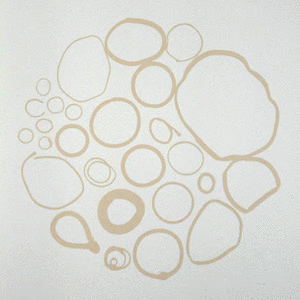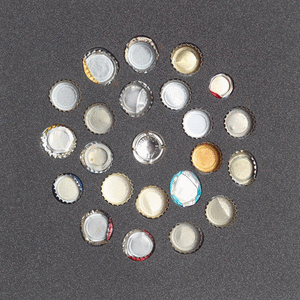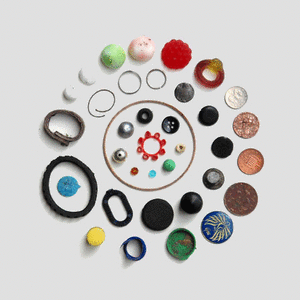RUCKLIDGE, Joanna (2014). Going Round in Circles. [Artefact] [Artefact]
What story can waste products tell us about our culture?
In 2014, I was commissioned to produce a piece of work for a group exhibition being hosted by the Herbert Art Gallery & Museum in Coventry, within the CCCA (the Coventry Centre for Contemporary Art). The brief was to ‘creatively present found objects relating to Coventry in a way that captures a connection to the Museum’s own collection’. I visited Coventry twice before producing a series of nine pieces of work – using found objects, & representations of them. I exhibited the pieces alongside works by artists Martin Green and Lorsen Camps, as part of ‘Shed-Collect-Shed: Coventry’s Lost & Found’ exhibition.
I titled the work, ‘Going Round in Circles’, as Coventry has been circled by a ring road since the 1970s, and is also famed for its history of bicycle, car, speedometer and clock production. These circular emblems inspired me to do ‘round’ walks in Coventry, whilst collecting hundreds of round objects from the streets. The objects were mostly packaging; lids and caps, along with other things like rubber bands, buttons, washers etc. They were ostensibly unsurprising ‘finds’, but constituted a true reflection of Coventry life; the remnants and remains, discarded or lost, only to be found again on that day in June.
I borrowed some methods of display directly from the Herbert’s exhibition techniques, for example, wiring onto perspex or framing securely within (laser cut) foam mounts. Others I reproduced using techniques to simplify the objects into two-dimensional graphic forms, using their silhouette for solar and screenprints, capturing their memory as a trace.
This project is not aimed to pass comment on how a city’s population responds to litter or how a council keeps a city clean & habitable, but it can begin to reflect how waste materials are generally undervalued and a disposable culture is seen as a normality. These objects function as contemporary archaeology, presenting a story from a privileged urban society, of many overlooked events, actions and, most importantly, resources.
Downloads
Downloads per month over past year
Actions (login required)
 |
View Item |


 Tools
Tools Tools
Tools![[thumbnail of Bands.jpg]](https://shura.shu.ac.uk/10457/1.hassmallThumbnailVersion/Bands.jpg)

![[thumbnail of Metal_bottle_lids.jpg]](https://shura.shu.ac.uk/10457/2.hassmallThumbnailVersion/Metal_bottle_lids.jpg)

![[thumbnail of Miscellanous_objects.jpg]](https://shura.shu.ac.uk/10457/3.hassmallThumbnailVersion/Miscellanous_objects.jpg)

